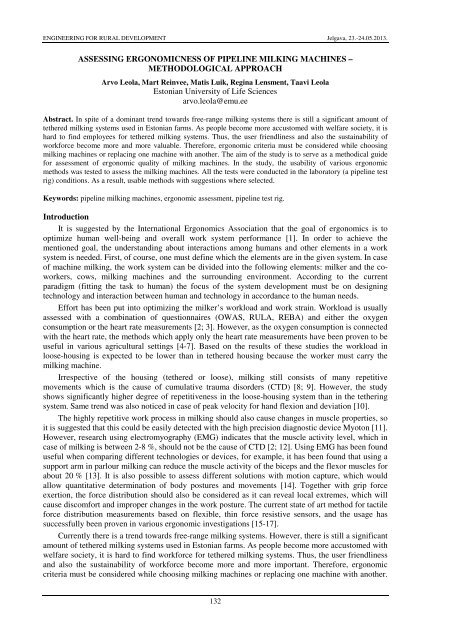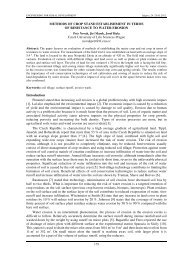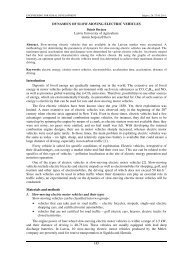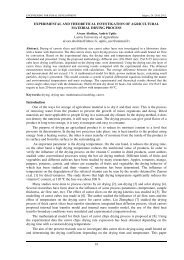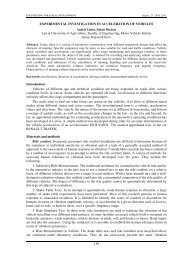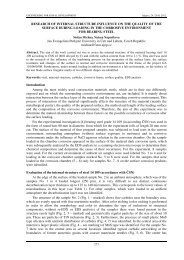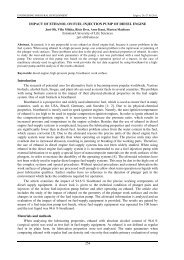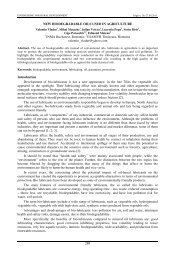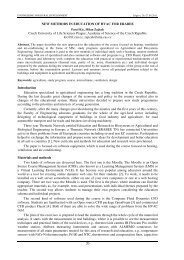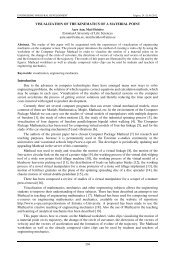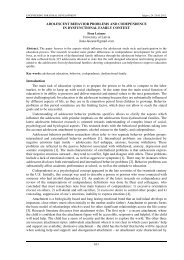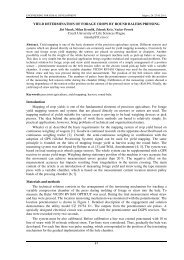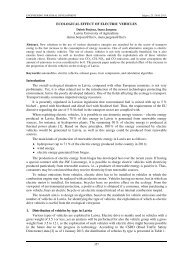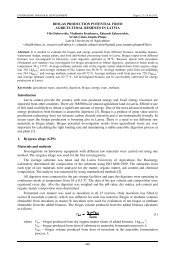Arvo Leola, Mart Reinvee, Matis Luik, Regina Lensment, Taavi ...
Arvo Leola, Mart Reinvee, Matis Luik, Regina Lensment, Taavi ...
Arvo Leola, Mart Reinvee, Matis Luik, Regina Lensment, Taavi ...
You also want an ePaper? Increase the reach of your titles
YUMPU automatically turns print PDFs into web optimized ePapers that Google loves.
ENGINEERING FOR RURAL DEVELOPMENT Jelgava, 23.-24.05.2013.<br />
ASSESSING ERGONOMICNESS OF PIPELINE MILKING MACHINES –<br />
METHODOLOGICAL APPROACH<br />
<strong>Arvo</strong> <strong>Leola</strong>, <strong>Mart</strong> <strong>Reinvee</strong>, <strong>Matis</strong> <strong>Luik</strong>, <strong>Regina</strong> <strong>Lensment</strong>, <strong>Taavi</strong> <strong>Leola</strong><br />
Estonian University of Life Sciences<br />
arvo.leola@emu.ee<br />
Abstract. In spite of a dominant trend towards free-range milking systems there is still a significant amount of<br />
tethered milking systems used in Estonian farms. As people become more accustomed with welfare society, it is<br />
hard to find employees for tethered milking systems. Thus, the user friendliness and also the sustainability of<br />
workforce become more and more valuable. Therefore, ergonomic criteria must be considered while choosing<br />
milking machines or replacing one machine with another. The aim of the study is to serve as a methodical guide<br />
for assessment of ergonomic quality of milking machines. In the study, the usability of various ergonomic<br />
methods was tested to assess the milking machines. All the tests were conducted in the laboratory (a pipeline test<br />
rig) conditions. As a result, usable methods with suggestions where selected.<br />
Keywords: pipeline milking machines, ergonomic assessment, pipeline test rig.<br />
Introduction<br />
It is suggested by the International Ergonomics Association that the goal of ergonomics is to<br />
optimize human well-being and overall work system performance [1]. In order to achieve the<br />
mentioned goal, the understanding about interactions among humans and other elements in a work<br />
system is needed. First, of course, one must define which the elements are in the given system. In case<br />
of machine milking, the work system can be divided into the following elements: milker and the coworkers,<br />
cows, milking machines and the surrounding environment. According to the current<br />
paradigm (fitting the task to human) the focus of the system development must be on designing<br />
technology and interaction between human and technology in accordance to the human needs.<br />
Effort has been put into optimizing the milker’s workload and work strain. Workload is usually<br />
assessed with a combination of questionnaires (OWAS, RULA, REBA) and either the oxygen<br />
consumption or the heart rate measurements [2; 3]. However, as the oxygen consumption is connected<br />
with the heart rate, the methods which apply only the heart rate measurements have been proven to be<br />
useful in various agricultural settings [4-7]. Based on the results of these studies the workload in<br />
loose-housing is expected to be lower than in tethered housing because the worker must carry the<br />
milking machine.<br />
Irrespective of the housing (tethered or loose), milking still consists of many repetitive<br />
movements which is the cause of cumulative trauma disorders (CTD) [8; 9]. However, the study<br />
shows significantly higher degree of repetitiveness in the loose-housing system than in the tethering<br />
system. Same trend was also noticed in case of peak velocity for hand flexion and deviation [10].<br />
The highly repetitive work process in milking should also cause changes in muscle properties, so<br />
it is suggested that this could be easily detected with the high precision diagnostic device Myoton [11].<br />
However, research using electromyography (EMG) indicates that the muscle activity level, which in<br />
case of milking is between 2-8 %, should not be the cause of CTD [2; 12]. Using EMG has been found<br />
useful when comparing different technologies or devices, for example, it has been found that using a<br />
support arm in parlour milking can reduce the muscle activity of the biceps and the flexor muscles for<br />
about 20 % [13]. It is also possible to assess different solutions with motion capture, which would<br />
allow quantitative determination of body postures and movements [14]. Together with grip force<br />
exertion, the force distribution should also be considered as it can reveal local extremes, which will<br />
cause discomfort and improper changes in the work posture. The current state of art method for tactile<br />
force distribution measurements based on flexible, thin force resistive sensors, and the usage has<br />
successfully been proven in various ergonomic investigations [15-17].<br />
Currently there is a trend towards free-range milking systems. However, there is still a significant<br />
amount of tethered milking systems used in Estonian farms. As people become more accustomed with<br />
welfare society, it is hard to find workforce for tethered milking systems. Thus, the user friendliness<br />
and also the sustainability of workforce become more and more important. Therefore, ergonomic<br />
criteria must be considered while choosing milking machines or replacing one machine with another.<br />
132
ENGINEERING FOR RURAL DEVELOPMENT Jelgava, 23.-24.05.2013.<br />
The aim of the paper is to determine the methods which allow testing of milking machines against<br />
ergonomic criteria.<br />
Materials and methods<br />
It is often said that a device is ergonomic if it is compatible with the worker’s physical and mental<br />
capacity. Thus, the ergonomic criteria in this research involved workload, complexity of operations<br />
(determined by task duration), changes in the muscle properties and the necessary grip force.<br />
Three milking machines were tested in laboratory conditions by using a test rig. The height of the<br />
milking pipeline was 1.86 m and the height of the vacuum pipeline was 1.93 m. The following milking<br />
machines were chosen for testing (Fig. 1) – Duovac (7.4 kg), MilkMaster (7.5 kg), and ADU1<br />
(4.0 kg). The milking machines vary by the design and mass, so it is expected that the differences have<br />
some impact on the workers’ ability to perform the tasks. In order to achieve more genuine simulation<br />
of the milkmaid’s work additional mass (bucket containing udder cleaning equipment) of 3.2 kg was<br />
used.<br />
Fig. 1. Milking machines in experiment<br />
The test subject had to take the milking machine from the pipeline, pick up the bucket, walk<br />
120 m, put down the bucket and connect the milking machine to the pipeline.<br />
Before and after the experiment the state of the muscle tension and muscle biomechanical<br />
parameters were measured with Myoton3, the subject’s heart rate was measured continuously with<br />
Polar s625x heart rate monitor, after the experiment an interview with the test subject was conducted.<br />
The experiment was recorded on video for task analysis. Differences of hand grip forces were<br />
measured with Teckscan Inc.’s tactile grip force and pressure measurement system using the sensor<br />
4256E.<br />
Results and discussion<br />
The collected heart rate data (Fig. 2) indicate the presence of the ceiling effect around 124 beats<br />
per minute (bpm). Although the milking machine Adu1 is about 3.5 kg lighter than other milking<br />
machines, significantly faster rise in the heart rate was detected. As the maximum heart rate is similar<br />
in all cases, then the cause is most likely the undesirable displacement posture (see Fig. 1). Also, the<br />
analysis of variance (ANOVA) allows to conclude that differences in the heart rate (and thus also in<br />
workload) were not statistically different (F = 1.92, p = 0.15). A conclusion may be drawn that the<br />
weight of the milking machine cannot be connected with ergonomic criteria.<br />
133
ENGINEERING FOR RURAL DEVELOPMENT Jelgava, 23.-24.05.2013.<br />
Surprisingly, the durations on the test seemed to depend on the milking machine. Thus, a task<br />
analysis was conducted based on video recordings. The experiment was subtracted into three tasks.<br />
Task 1 was either connecting or disconnecting the milking machine to or from the test rig. Task 2 was<br />
picking up the bucket with cleaning equipment and exiting the milk room. Task 3 – walking 120 m<br />
with the equipment, entering the milk room and putting down the cleaning equipment. The results<br />
(Fig. 2) indicate stable pace of task 3 (MilkMaster 1:21; Duovac 1:23; Adu1 1:24) in all cases.<br />
Interestingly, the difficulty level of connecting the milking machine with the test rig was one of the<br />
main factors influencing the test duration. Another key factor was the design of the attachment of the<br />
milking cluster and handle unit. If the attachment is poorly designed then the worker has to remain<br />
alert in order to avoid stumbling.<br />
Fig. 2. Heart rate (bpm) during experiment<br />
Fig. 3. Duration of tasks<br />
Contrary to the expectations, this study did not find a significant difference in Trapezius muscle<br />
properties changes when comparing the milking machines. Surprisingly, no differences were found<br />
even in after and before measurements (Table 1). The biggest change was detected in case of left<br />
Trapezius dynamic stiffness, however, the left hand was used to hold the cleaning equipment, and thus<br />
it has little to do with the milking machine assessment.<br />
134
ENGINEERING FOR RURAL DEVELOPMENT Jelgava, 23.-24.05.2013.<br />
This finding was unexpected and suggests that further studies should extend the test duration by<br />
either prolonging the distance of carrying or repeating measurements after multiple test cycles.<br />
Table 1<br />
Changes in muscle properties (∆ = After-Before)<br />
Milking<br />
machine<br />
Tension,<br />
Hz<br />
Right Trapezius muscle<br />
Elasticity<br />
Dynamic<br />
Stiffness,<br />
N·m -1<br />
Tension,<br />
Hz<br />
Left Trapezius muscle<br />
Elasticity<br />
Dynamic<br />
Stiffness,<br />
N·m -1<br />
MilkMaster 1.2 -0.05 -24 -1.4 0.21 -93<br />
Duovac 0.8 0.11 7 1.0 0.00 0<br />
ADU1 1.3 0.10 5 0.3 0.14 3<br />
In case of Duovac or MilkMaster, it is possible to carry the milking machine with either neutral<br />
hand position (first row in Table 2) or flexed forearm (second row in Table 2). Adu1 in its minimal<br />
and simple design is meant to be carried with somewhat undesired posture. However, the measured<br />
grip force is the lowest in case of Adu1.<br />
Table 2<br />
Grip forces in different postures<br />
Posture<br />
Grip force, N<br />
MilkMaster Duovac ADU1<br />
309 329 -<br />
398 506 -<br />
- - 100<br />
The handle of MilkMaster is twice as long as the Duovac handle, which allows the worker to grip<br />
the handle as near as possible to the center of gravity. As the torque component can be brought to a<br />
minimum noticeable lower grip force is needed. The difference is not perceived in case on neutral<br />
hand position (first row in Table 2) but in case of a shorter worker the feet could get tangled with the<br />
milk hose or vacuum tubes. Thus, if the worker has to flex the forearm from the elbow a milking<br />
machine with a longer handle is preferred.<br />
Conclusion<br />
All the methods utilized in this study could be used in ergonomic assessment of milking<br />
machines. However, using Myoton 3 requires more skills and knowledge in order to ensure useful<br />
results.<br />
Based on our methodology and the current experiment Milkmaster is preferred to other milking<br />
machines. Although Adu1 is lighter and the necessary griping force is the lowest it is less automated<br />
and one has to carry it with undesired posture.<br />
A number of possible future studies using the same experimental set up are apparent. It would be<br />
interesting to assess the effects of milking machines on the work strain in case of multiple work<br />
cycles.<br />
References<br />
1. International Ergonomic Association – What is Ergonomics. [online] [01.03.2013]. Available at:<br />
http://www.iea.cc/01_what/What%20is%20Ergonomics.html.<br />
2. Nevala-Puranen N., Kallionpää M., Ojanen K. Physical load and strain in parlor milking.<br />
International Journal of Industrial Ergonomics, vol. 18, 1996, pp. 277-282.<br />
135
ENGINEERING FOR RURAL DEVELOPMENT Jelgava, 23.-24.05.2013.<br />
3. Perkiö-Mäkeläa M., Hentilä H. Physical work strain of dairy farming in loose housing barns.<br />
International Journal of Industrial Ergonomics, vol. 35, 2005, pp. 57-65.<br />
4. Mikson E., Reppo B. Energetic load of herdsman by the operating environment of uninsulated<br />
cowshed. Proceedings of „Advanced technologies for energy producting and effective<br />
utilization“, 2004, Jelgava, Latvia, pp. 151-156.<br />
5. Mikson E., Reppo B., <strong>Luik</strong> E. Herdsman's work load rate and ability of work in a farm with an<br />
uninsulated cowshed. Proceedings of „Actual tasks on agricultural engineering“, 2005, Opatija,<br />
Croatia, pp. 495-505.<br />
6. Sada O, Reppo, B. Working time expenses and degree of difficulty of pig tending. Journal of<br />
agricultural science, vol. 1, 2006, pp. 68-77.<br />
7. Sada O, Reppo, B. Working time expenses and degree of difficulty of fatlings tending.<br />
Proceedings of „Actual tasks on agricultural engineering“, 2010, Opatija, Croatia, pp. 429-437.<br />
8. Stål M., Moritz, U., Gustafsson B., Johnsson B. Milking is a high-risk job for young females.<br />
Scandinavian Journal of Rehabilitation Medicine, vol 28, 1996, pp. 95-104.<br />
9. Stål M., Moritz M., Johnsson B., Pinzke S. The natural course of musculoskeletal symptoms and<br />
clinical findings in upper extremities of female milkers. International Archives of Occupational<br />
and Environmental Health, vol. 3, 1997, pp 190-197.<br />
10. Stål M., Hansson G-Å., Moritz U. Wrist positions and movements as possible risk factors during<br />
machine milking. Applied Ergonomics, vol. 30, 1999 pp. 527-533.<br />
11. Bizzini M., Mannion A.F. Reliability of a new, hand-held device for assessing skeletal muscle<br />
stiffness. Clinical Biomechanics, vol. 18, 2003, pp. 459-461.<br />
12. Stål M., Hansson G-Å., Moritz U. Upper extremity muscular load during machine milking.<br />
International Journal of Industrial Ergonomics, vol. 26, 2000, pp. 9-17.<br />
13. Stål M., Pinzkea S., Hansson G-Å. The effect on workload by using a support arm in parlour<br />
milking. International Journal of Industrial Ergonomics, vol. 32, 2003, pp. 121-132.<br />
14. Jakob M., Liebers F., Behrendt S. The effects of working height and manipulated weights on<br />
subjective strain, body posture and muscular activity of milking parlor operatives - Laboratory<br />
study. Applied Ergonomics, vol. 43, 2012, pp. 753-761.<br />
15. Welcome D., Rakheja, S., Dong R., Wu J.Z., Schopper A.W. An investigation on the relationship<br />
between grip, push and contact forces applied to a tool handle. International Journal of Industrial<br />
Ergonomics, vol. 34, 2004, pp. 507-518.<br />
16. Kuijt-Evers L.F.M., Bosch T., Huysmans M.A., de Looze M.P., Vink P. Association between<br />
objective and subjective measurements of comfort and discomfort in hand tools. Applied<br />
Ergonomics, vol. 38, 2007, pp. 643-654.<br />
17. Kutz D.F., Wölfel A., Timmann D., Kolb F.P. Detection of changes in grip forces on a sliding<br />
object. Journal of Neuroscience Methods, vol. 166, 2007, pp. 250-258.<br />
136


